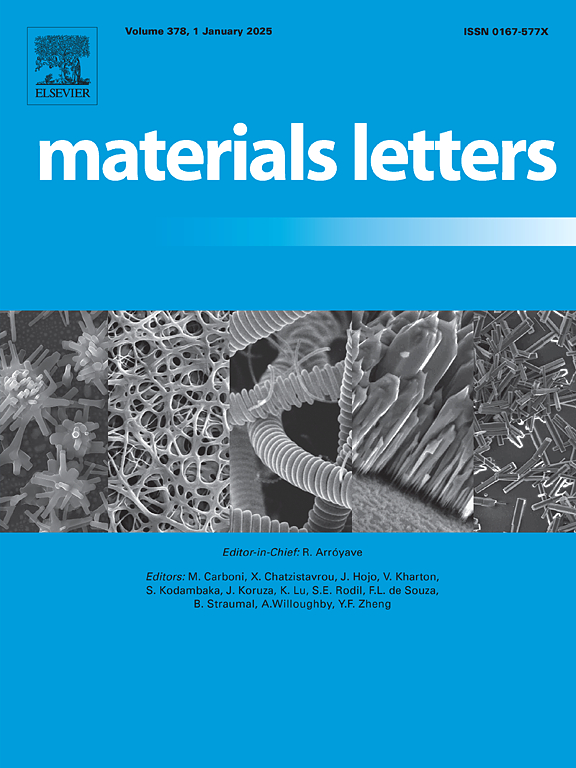Fabrication of stable MAPbI3 perovskite via e-spray technique- hydration and phase reversibility
IF 2.7
4区 材料科学
Q3 MATERIALS SCIENCE, MULTIDISCIPLINARY
引用次数: 0
Abstract
This study reports the fabrication of robust methylammonium lead iodide (MAPI) films via the e-spray technique, utilizing controlled and reversible hydration to enhance optoelectronic properties. Moisture in MAPI-based perovskite solar cells (PSCs) can either recrystallize or degrade the material, depending on the degree of hydration. The formation of hydrated perovskite phases (CH3NH3PbI3·H2O and CH3NH3PbI3·2H2O) and their phase reversibility are demonstrated in spray-coated MAPI films deposited under electric fields (E-fields). X-ray diffraction and absorption spectra reveal phase transitions influenced by the E-field during deposition. The resultant films, terminated with PbI2, exhibit reduced hydration (mono- or di-hydrated phases), forming a robust structure. Upon annealing, these hydrated phases revert to the perovskite phase. This work highlights the beneficial role of controlled hydration in MAPI films, offering insights into improving their stability and optoelectronic performance for PSC applications.
电子喷雾法制备稳定的MAPbI3钙钛矿-水化和相可逆性
本研究报告介绍了通过电子喷雾技术制造坚固的碘化甲铵铅 (MAPI) 薄膜,利用可控和可逆的水合作用增强光电特性。基于 MAPI 的过氧化物太阳能电池 (PSC) 中的水分会使材料重结晶或降解,具体取决于水合程度。在电场(E-fields)下沉积的喷涂 MAPI 薄膜中显示了水合包晶相(CH3NH3PbI3-H2O 和 CH3NH3PbI3-2H2O)的形成及其相的可逆性。X 射线衍射和吸收光谱显示了沉积过程中受电场影响的相变。以 PbI2 为端基的薄膜呈现出水合减少的现象(单水合或双水合相),形成了坚固的结构。退火时,这些水合相会恢复为包晶相。这项工作强调了受控水合在 MAPI 薄膜中的有益作用,为提高其稳定性和光电性能以用于 PSC 应用提供了启示。
本文章由计算机程序翻译,如有差异,请以英文原文为准。
求助全文
约1分钟内获得全文
求助全文
来源期刊

Materials Letters
工程技术-材料科学:综合
CiteScore
5.60
自引率
3.30%
发文量
1948
审稿时长
50 days
期刊介绍:
Materials Letters has an open access mirror journal Materials Letters: X, sharing the same aims and scope, editorial team, submission system and rigorous peer review.
Materials Letters is dedicated to publishing novel, cutting edge reports of broad interest to the materials community. The journal provides a forum for materials scientists and engineers, physicists, and chemists to rapidly communicate on the most important topics in the field of materials.
Contributions include, but are not limited to, a variety of topics such as:
• Materials - Metals and alloys, amorphous solids, ceramics, composites, polymers, semiconductors
• Applications - Structural, opto-electronic, magnetic, medical, MEMS, sensors, smart
• Characterization - Analytical, microscopy, scanning probes, nanoscopic, optical, electrical, magnetic, acoustic, spectroscopic, diffraction
• Novel Materials - Micro and nanostructures (nanowires, nanotubes, nanoparticles), nanocomposites, thin films, superlattices, quantum dots.
• Processing - Crystal growth, thin film processing, sol-gel processing, mechanical processing, assembly, nanocrystalline processing.
• Properties - Mechanical, magnetic, optical, electrical, ferroelectric, thermal, interfacial, transport, thermodynamic
• Synthesis - Quenching, solid state, solidification, solution synthesis, vapor deposition, high pressure, explosive
 求助内容:
求助内容: 应助结果提醒方式:
应助结果提醒方式:


